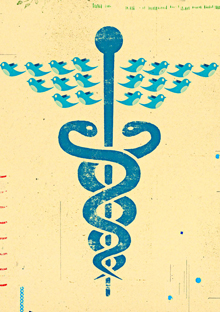Twitter: Now Saving Lives

Illustration: Richard Mia
Your cell phone rings—and you find this text message:"We are drilling through the skull."
Gruesome? Not for the 1,900 medical students, healthcare practitioners, patients, and ordinary citizens who followed a live Twittercast of a five hour brain surgery at Henry Ford Hospital in Detroit last spring.
Twitter is the mini-blogging tool better known for keeping your BFs in the loop when you're headed out for espresso. But the technology has taken hold in medicine: Medical centers are starting to use Twitter to stay in touch with patients; when research suggested that a form of insulin used by people with diabetes might raise cancer risk, the Joslin Diabetes Center in Boston tweeted a link to more information. The World Health Organization sends updates on swine flu. And in a nod to how useful the tool can be, the British Medical Journal published an online guide to Twitter.
Steven Kalkanis, MD, the neurosurgeon whose team tweeted during brain surgery last spring, believes Twitter is valuable as a teaching tool. "It can serve as a real-time classroom for medical students," he says. "We were also showing surgery on YouTube and taking questions. We got everything from 'What music are you listening to in the background?' to 'What kind of anesthesia are you using?'"
Twitter's real power, however, may be its ability to get the word out: Earlier this year tweets and retweets of messages like "kid needs bone marrow transplant" helped publicize the story of a 5-year-old New York City girl with an aggressive form of leukemia. Thousands of people registered as potential bone marrow donors, and a match was found. Jasmina Anema got her bone marrow transplant on June 11. It was a success. On July 24 she posted to Twitter, "Today was the BIG DAY: I was going home and had a candy party!"
Keep reading: Do topical creams actually work?
Gruesome? Not for the 1,900 medical students, healthcare practitioners, patients, and ordinary citizens who followed a live Twittercast of a five hour brain surgery at Henry Ford Hospital in Detroit last spring.
Twitter is the mini-blogging tool better known for keeping your BFs in the loop when you're headed out for espresso. But the technology has taken hold in medicine: Medical centers are starting to use Twitter to stay in touch with patients; when research suggested that a form of insulin used by people with diabetes might raise cancer risk, the Joslin Diabetes Center in Boston tweeted a link to more information. The World Health Organization sends updates on swine flu. And in a nod to how useful the tool can be, the British Medical Journal published an online guide to Twitter.
Steven Kalkanis, MD, the neurosurgeon whose team tweeted during brain surgery last spring, believes Twitter is valuable as a teaching tool. "It can serve as a real-time classroom for medical students," he says. "We were also showing surgery on YouTube and taking questions. We got everything from 'What music are you listening to in the background?' to 'What kind of anesthesia are you using?'"
Twitter's real power, however, may be its ability to get the word out: Earlier this year tweets and retweets of messages like "kid needs bone marrow transplant" helped publicize the story of a 5-year-old New York City girl with an aggressive form of leukemia. Thousands of people registered as potential bone marrow donors, and a match was found. Jasmina Anema got her bone marrow transplant on June 11. It was a success. On July 24 she posted to Twitter, "Today was the BIG DAY: I was going home and had a candy party!"
Keep reading: Do topical creams actually work?



